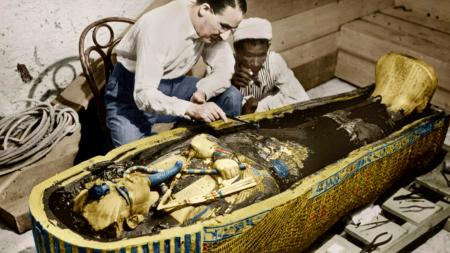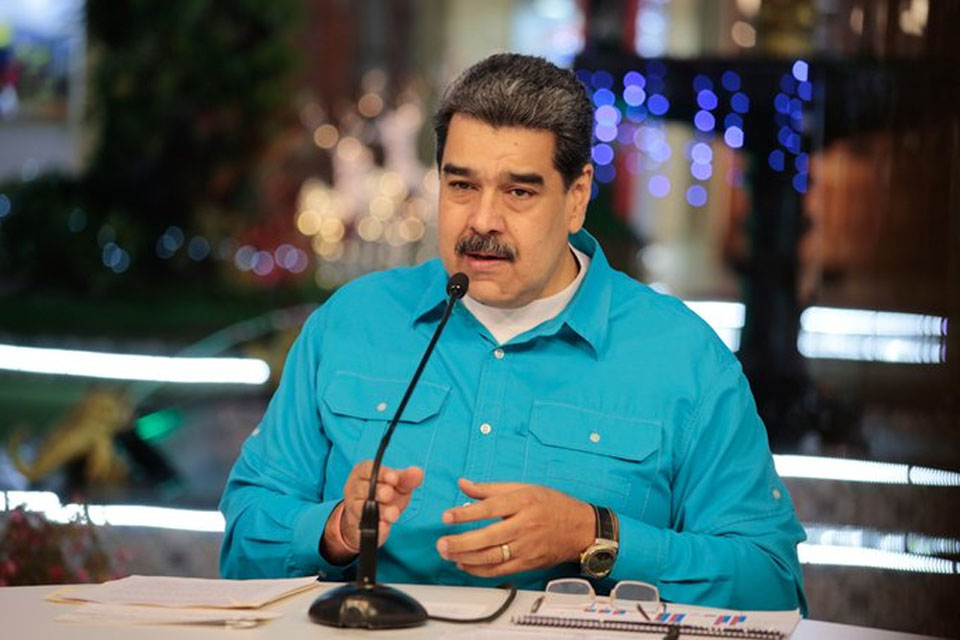The discovery of the tomb of the Egyptian pharaoh Tutankhamun and its treasures will be 100 years old this Friday and constituted a milestone in “Egyptomania” and in the scientific study of the civilization of Ancient Egypt, with great media coverage that fueled the mystery of “The curse of the mummy”, on which DNA tests were even carried out.
The anniversary of the discovery coincides with the bicentenary of the “deciphering of hieroglyphs”, carried out in 1822 by the French historian Jean Francois Champollion, considered the “Father of Egyptology”.
About Tutankhamun
Tutankhamun came to the throne at the age of 9 during the period of the 18th Dynasty and had a “very short” reign, ten years (1336-1327 BC) until his death at 19, the Conicet researcher and founder of the Center for the Study of Ancient Eastern History at the Argentine Catholic University, Roxana Flammini, recalled in dialogue with Télam, who adheres to the Tutankhamón spelling while the Fundéu RAE says it is preferable to write it without an ax.
Discovery of his tomb
The discovery was made by the English archaeologist Howard Carter on November 4, 1922when after a long expedition that had begun in 1914 and was suspended during the First World War (until 1918), one of the team members finally found the first step of the tomb’s stairs.
For the expedition in the Valley of the Kings, an ancient Egyptian necropolis where the tombs of most of the pharaohs were found, the archaeologist managed to get Lord George Herbert of Carnarvon, an English earl who had obtained the difficult permission to dig there, finance the search with the warning that this year -1922- “would be the last one that would finance him”.
According to the historian, the discovery had multiple meanings due to the context in which it took place, since the end of the First World War was recent and 1922 was the last of the English protectorate in Egypt and “for the Egyptians to find their own king -who had disappeared from history with wonderful things – was linked to freedom”.
His reign and polytheism
During his reign, Tutankhamun restored the polytheism and the cult of the god Amun, to the Karnak temple and the city of Thebes as the seat of royaltywho had been exchanged for who (possibly) was his father, Akhenaten, during the rule that preceded him, in a “very troubled” period of Ancient Egyptian history.
Previously, Akhenaten had carried out a monotheistic reform centered on the god Aten and had even left Thebes, the seat where royalty resided in Egypt, to found a new city called Akhetaten (today, El Amarna).
“That of Tutankhamun is a short reign, but with relevance because it ends with what was happening with the reform of El Amarna and returns to the previous cult”highlighted Flammini, who is also a professor at the National University of Luján.
However, he added, being associated with the period of the El Amarna kings, Tutankhamun was a pharaoh “invisible” in the lists of kings.
Although the tomb had suffered two looting attempts in antiquity, the treasure “was practically intact”, because Tutankhamun was a king “almost forgotten by the Egyptians themselves” and in addition, the Valley of the Kings had suffered a flood that left sediments that covered it and ended up protecting it, added the professor.
Two hypotheses about his death
On the death of Tutankhamun, there are different hypotheses: that malaria could have killed him; that he broke his leg and developed gangrene that killed him; and that he could have had an accident, because the mummy has a sunken chest and her heart was not found, Flammini said.
“It is very likely that it was an accident with a war chariot at high speed and that this caused his death. It was violent,” he considered.

Regarding the genealogy of Tutankhamun, in recent decades, researchers have carried out DNA studies on the mummy and have argued that “He would be the direct son of Akhenaten, the king of El Amarna, with a secondary wife who could surely be a sister of the king, which would give rise to a series of genetic diseases that the mummy could present”“, mentioned the researcher and warned that these are studies that are the subject of debate.
“The Egyptians embalmed the body and extracted the organs. They carried out a process in which the body is completely dissected to start a series of rituals in which the body is wrapped with bandages and resins, and amulets are placed on it. Then they carry out the burial process, the tomb and its sealing,” he specified.
“Tutankhamun made Ancient Egypt massive and popular”
The discovery of the tomb of Tutankhamun, on November 4, 1922, “made Ancient Egypt massive and popular”, a topic that until then had only challenged scholars, told Télam the Conicet researcher and professor of Ancient History, Matías Alderete.
The British publication ‘The Times’ had, at the time of the discovery, journalistic exclusivity over all the research and photographic material of the archaeological expedition.
“The press made society participate in the findings and the phenomenon at a global level. An issue that has to do with urban modernity that takes up ancient elements to build myths of enchantment and fascination,” added the author of the work “The charm of Tutankhamun. Egyptomania in the Buenos Aires press (1923-1925)”.
The Buenos Aires media also tried to be part of the world by showing these images, echoing the global news, and, by 1924, even Carlos Gardel sang a tango to Tutankhamun.
“In the 1920s, Ancient Egypt and the East in general were topics that enchanted the inhabitants of Buenos Aires in a process of modernization, which was experienced as ‘everyday enchantment’ and meant ‘being part of a cosmopolitan modernity,'” said the researcher, highlighting that throughout 1923 and until -at least- 1925 in the mass press there was a presence of Ancient Egypt and Tutankhamun.
In popular newspapers, such as Crítica and illustrated weeklies, the presence was reflected in the intense visual load, with illustrations by local artists or international news agencies.
Also, some publications presented satires and advertisements for objects, clothing and products in the Egyptian and Tutankhamun style, such as rings, earrings, headdresses, handbags, which were offered at different prices, aimed at people from different social sectors.
According to Alderete, in the coverage of the Buenos Aires press, there were two well-differentiated moments: the first during the first part of 1923, when they provided a lot of information about the discovery.
And, the second, from the death of the Lord of Carnarvon in April 1923 (from an infection), which is when the load of the news “began to change” and “more exotic ideas about the mummy, and about the Pharaoh’s curse.”
The second stage was linked, for the author, with a Western idea of fear of death and the dead: “There is a fascination and at the same time it is terrifying to think that the dead return from beyond,” he specified.
As ‘The Times’ had the exclusivity of everything and the rest of the English media could only reproduce cables and “had nothing to show” or say about the investigation – Alderete reconstructed -, Carnarvon’s death “allowed all these newspapers exploit the event and build legends”.
This is how some appeared that indicated that “Cairo when Carnarvon died was totally dark, or that howls were heard”, with which they sought “to go around death in the Egyptians, the world beyond the grave, the curse of the mummy, a phenomenon that is sustained a lot,” he warned.
Furthermore, the figure of the mummy “aroused Western desires and taboos”. Among them, the desecration of the tombs and the body.
The subject overflowed the literary sphere and Egyptomania, which is “a long-standing social phenomenon linked to a fascination and obsession with Ancient Egypt, is still present,” concluded the researcher.
When Carter broke the wall of one of the chambers, he found the outside of a large golden chapel that occupied the entire room and inside a box there were other boxes that led to a stone sarcophagus, where, in turn, there were several coffins.
In the last coffin, which was made of pure gold, lay the mummy of Tutankhamun, who had his funerary mask, one of the most photographed objects in the world, also made of pure gold.
The mask was glued to the mummy, as were a bunch of amulets and other objects that were on the mummy between the bandages. “To take off the mask, at the time, they were not very neat, the mummy was very damaged,” said Flammini.
In the tomb they found over 5,000 “fascinating” objects from the period, among them, fans with preserved ostrich feathers, war chariots, jewels, statues and thrones of gilded wood, which “accompanied the pharaoh to life in the afterlife”, a characteristic belief of the Egyptians; and “it took a long time to empty everything that was found there,” the researcher recalled.
The Cairo Museum

Currently, objects are in the Cairo museum, and the mummy in the tomb of the Valley of the Kings, inside a glass chamber that is completely conditioned so that it does not disintegrate.

“The discovery of the tomb of Tutankhamun remained in our collective history as a moment of enlightenment about ancient Egypt that interested and fascinated many people, and reinforced Egyptmania; some turned more to the academic field (Egyptology) and others to the of general interest, but it challenged all of us in some way, that is the great impact it has,” said the historian.

In addition, this discovery was of interest from the first moment for the media around the world, which promoted the idea of the “Mysterious Egypt and that the king had powers from beyond the grave so that ‘whoever dared to alter his eternal sleep would die'”.
Added to the death of the Lord of Carnarvon the following year due to an infection of a wound, the stories that were already circulating previously in England in the 19th century, and the fact that certain formulas were written on the tombs of the kings that said that “there is no the sleep of the deceased was interrupted”, interpreted as curses, the fire of “Egyptomania” was rekindled.



















